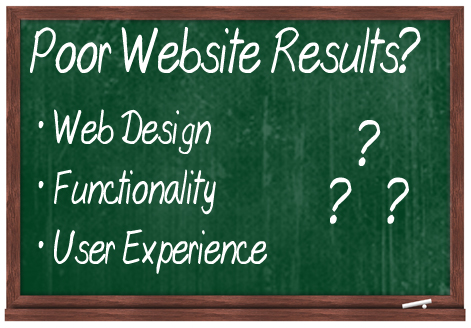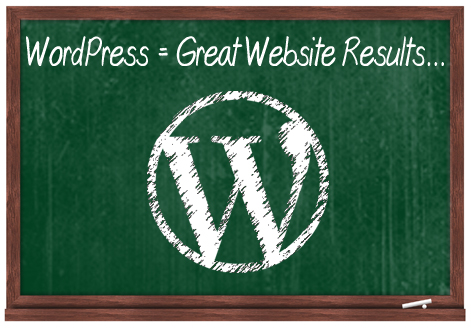 Are you missing out on business because of poor web design? Regardless of how professional your company is, a poorly-constructed website can end up losing you prospective new customers and cause more issues than you can handle.
Are you missing out on business because of poor web design? Regardless of how professional your company is, a poorly-constructed website can end up losing you prospective new customers and cause more issues than you can handle.
In a world where attractive design sells, how your website looks is becoming ever more important to the success of your business. Your website is probably the first thing that your potential customers see and this can influence their purchasing decision.
Think about how most people do research about businesses nowadays. Even if it’s only just preliminary research, we still switch to our smart device and go visit someone’s site first before purchasing goods in-store or online.
Now, put yourself in your visitor’s position. How does your web presence appear to others? Does your site invite them to come and explore things further, or does it make people hesitant and cautious about where to go next?
What your potential clients see “above the fold” (i.e. what you first see on your screen) is only the tip of the iceberg. There are so many other things than can influence your web visitors’ thoughts and their decision to ultimately engage and do business with you.
Can WordPress Fix Poor Web Design?
Let’s review some of the more important design issues that can affect your website:
Web Site Design Problems
Some of the most common web design problems that can affect a potential customer’s perception of your website include some or all of the following:
- Color – Unattractive color schemes can affect your results. This also applies to your choice of text and background color. There are tools to pick web colors correctly and even safe web colors to make sure that the colors you choose will display correctly across different devices. If in doubt, consult a professional web designer.
- Design Elements – Pages that contain aesthetically unexciting, outdated or just plain ugly graphic elements can result in users quickly losing interest in away from your site. Visitors can also be affected by inconsistent graphic element choices or excessive use of design elements.
- Layout – How your pages are laid out can affect how visitors interact with your site. Layout considerations also include where your navigational menus, links, and other objects.
- Responsiveness – As websites are now viewed by various devices with different-sized browsers, it’s vitally important that the design of your website be responsive. If your website does not resize automatically to work across all devices, browsers, and platforms, you could lose customers.
Web Site Functionality Problems
Typical functionality issues include:
- Subpar functionality – A huge turn-off for visitors is arriving on a website where some links don’t work, videos don’t play and graphics aren’t showing. Frequent errors are no longer acceptable, especially if you are trying to come across as a professional and dependable company. Your online presence reflects your business. It’s vitally important to make sure that all your links, videos, and images are up and running at all times. In some cases, these problems could be caused by factors like your web hosting, or they may even be unbeknownst to you, but it’s important to make sure that remain proactive and that all problems get addressed immediately.
- Feature limitations – If your web site offers visitors certain functionality, then make sure that these features are not limited. For example, if you plan to sell products online, make sure that you provide visitors with full e-commerce functionality that allow them to select and add items to a shopping cart, apply discount codes, complete purchases with credit cards or PayPal, receive notifications, receipts, and confirmations, etc.
Poor User Experience
Normally, where customers suffer most due to a poorly-built site is the “user experience”.
Anything less than a great user experience can leave a bad taste in people’s mouths and lead them to vent their dissatisfaction on social networks, forums, review sites, commenting sections, etc., bringing you negative publicity.
Here are just some common problems that can create a poor user experience:
- Ease Of Use – Your site needs to be easy to use and easy to navigate around in. Your product information should be easy to find. Your potential customers want user-friendly features and they want to find what they are looking for as quickly and as effortlessly as possible. Make your content searchable and if you plan to add downloadable content to your site (e.g. forms and documents), make sure that visitors are given instructions on how to download and access your files.
- Organization – If your site isn’t organized and user-friendly, you run the risk of losing not only potential customers but also existing customers. Features such as search engine-friendly links, product and service categories and clean sections where related content can be easily found will provide users with a good user experience.
- Stimulating Web Site – Users stick around on websites that are user friendly, easy to navigate, and that provide them with eye-catching options. This requires aiming for a balance between attractive, modern web design and compelling web copy that engages your users. For example, highlight links pointing to your product pages with great graphics beside well-written descriptions. This is effective and can help improve not only the user experience on your site, but also improve your sales and conversions.
- Engaging Features – Another thing that helps to improve user experience on your website is providing interactive features that engage visitors, like the ability to comment on, share, like, download and recommend your content, interact with your support staff via a responsive helpdesk, support forum, live chat, schedule appointments, make reservations, etc … You also want users to be able to navigate quickly around your website and access your information without waiting around for pages to load, so site loading optimization is important.
- Trustworthy Website – One of the most important and often most ignored aspects of creating a great user experience is to make users feel confident interacting with you online. To reassure your web visitors that your company is credible, trustworthy, secure and professional to deal with, make sure to add legal pages such as a business contact page, privacy statement, terms of usage, security information, financial disclaimers, etc.

(Web design issues)
As you can see, there are many areas that can contribute to a poor user experience and impact your business results online. If your site isn’t designed in a user-friendly way, you run the serious risk of not only losing potential clients but also your current clients as well.
Now … what if you have arrived on our site because you currently have an existing website with design issues that you feel are affecting your business?
First, be aware that getting issues fixed on an existing website can take time and can also end up being quite costly depending on the problem and what kind of website you own, especially if what needs doing requires extensive code editing.
If you are currently considering getting a new website developed or redesigning an existing website, then we recommend that you consider using WordPress.

(WordPress can help to improve your website results!)
We currently share more in-depth articles about the benefits and advantages of WordPress on this site, but here are just a few of the things to keep in mind about why you should seriously choose WordPress:
Themes – Unique Web Design Features
WordPress themes are unique web design templates that allow you to completely modify the look of your site without affecting the website’s content or modifying the underlying site functionality.
There are thousands of great-looking WordPress themes available that you can install on your site. Many of these are either free of charge, or they are relatively cheap, saving you thousands of dollars on the cost of website design.

(WP Themes)
Most themes are responsive and provide you with flexible and customizable features for changing your website’s design settings such as the color, elements like headers, footers, menus and styles, layouts and more. Themes are just part of what makes WordPress an ideal tool for helping you create a design for your website that helps your business.
Learn about WP themes here:
WordPress – Modular Scalability
Another great reason to choose the WP CMS is that WordPress gives you almost unlimited features through add-on applications called “plugins.”
WP plugins, like WP themes, integrate easily with your site to provide you with virtually unlimited additional functionality.
Earlier in this post we talked about issues in areas like subpar functionality and feature limitations as part of the reason why a poorly designed website can end up costing you customers.
WP plugins can help you overcome these issues and limitations quite easily and inexpensively. If there is a feature you need to integrate with your site, just install a WordPress plugin that will help you get things done.
Want a plugin that will notify you about any problems with your website like links not working, audios not playing, pictures that are missing or even tell you if your whole site is down? No problems … there are plugins that can help you fix that, or notify you about issues so you can correct these immediately!
Want a plugin that will let you turn your site into an online store or provide you with a complete e-commerce business solution? Again, no problem! There are several inexpensive WordPress plugins that will help you sell goods or services on your site and provide your users with full e-commerce features that allow them to easily choose and add products to a shopping cart, apply discount coupons, order using credit card or PayPal, receive notifications, receipts and email confirmations, etc.
And just like themes, there are tens of thousands of fantastic plugins for WordPress that you can download and easily install on your website and are freely available, or are relatively cheap, once again, saving you hundreds, even thousands of dollars on the cost of web development.

(WordPress Plugins)
Learn more about WordPress plugins here:
WordPress – An Interactive User Experience
In addition to being able to correct issues caused by a poorly-constructed website, WordPress can also help you create a great user experience for your site users.
WordPress provides beautiful and visually-exciting themes that cover all kinds of applications and plugins that allow customers to connect, engage and interact online with you. With the right combination of a WordPress-driven site, WordPress themes and plugins, plus great content, you can create a rich and interactive user experience that will keep them coming back for more.

As stated earlier, consumers nowadays do extensive research online before they make a purchasing decision. If your website isn’t designed to provide your visitors with a rich and engaging user experience, they will simply move on to another business with a better website.
Hopefully, now you have a better understanding of problems that can affect your website and how WordPress can help you build a better online. To learn more about using WordPress for a business website please see our related posts section.
***
"This is AMAZING! I had learnt about how to use WordPress previously, but this covers absolutely everything and more!! Incredible value! Thank you!" - Monique, Warrior Forum
***